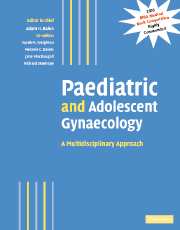Book contents
- Frontmatter
- Contents
- Contributors
- Preface
- Part I Normal development
- Part II Management of developmental abnormalities of the genital tract
- Part III Management of specific disorders
- 18 Disorders of growth and puberty
- 19 Turner's syndrome
- 20 Androgen insensitivity syndromes
- 21 Rokitansky syndrome and other Müllerian anomalies
- 22 The XY female
- 23 The gynaecology of the major genitourinary anomalies
- 24 Congenital adrenal hyperplasia
- 25 Long-term sequelae of genital surgery
- 26 Amenorrhoea
- 27 The polycystic ovary syndrome and adolescent women
- 28 Menstrual disorders in adolescent girls
- 29 Pelvic pain, ovarian cysts and endometriosis in adolescent girls
- 30 Premature ovarian failure and ovarian ageing
- 31 Gynaecological cancers in childhood
- 32 Late reproductive sequelae of treatment for childhood cancer
- 33 Preservation of fertility before cancer therapy
- 34 The management of infertility with surrogacy and egg donation
- 35 Dermatological conditions of the female genitalia
- 36 Vaginal discharge
- 37 Psychological gender development in individuals born with ambiguous genitalia
- 38 Eating disorders in adolescence
- 39 Nutritional amenorrhoea: long-term sequelae
- 40 How to set up a service: how to teach and train
- Index
- Plate section
- References
27 - The polycystic ovary syndrome and adolescent women
from Part III - Management of specific disorders
Published online by Cambridge University Press: 04 May 2010
- Frontmatter
- Contents
- Contributors
- Preface
- Part I Normal development
- Part II Management of developmental abnormalities of the genital tract
- Part III Management of specific disorders
- 18 Disorders of growth and puberty
- 19 Turner's syndrome
- 20 Androgen insensitivity syndromes
- 21 Rokitansky syndrome and other Müllerian anomalies
- 22 The XY female
- 23 The gynaecology of the major genitourinary anomalies
- 24 Congenital adrenal hyperplasia
- 25 Long-term sequelae of genital surgery
- 26 Amenorrhoea
- 27 The polycystic ovary syndrome and adolescent women
- 28 Menstrual disorders in adolescent girls
- 29 Pelvic pain, ovarian cysts and endometriosis in adolescent girls
- 30 Premature ovarian failure and ovarian ageing
- 31 Gynaecological cancers in childhood
- 32 Late reproductive sequelae of treatment for childhood cancer
- 33 Preservation of fertility before cancer therapy
- 34 The management of infertility with surrogacy and egg donation
- 35 Dermatological conditions of the female genitalia
- 36 Vaginal discharge
- 37 Psychological gender development in individuals born with ambiguous genitalia
- 38 Eating disorders in adolescence
- 39 Nutritional amenorrhoea: long-term sequelae
- 40 How to set up a service: how to teach and train
- Index
- Plate section
- References
Summary
Introduction
The polycystic ovary syndrome (PCOS) is the commonest endocrine disturbance affecting women, yet it is only in the 1990s that we have begun to piece together a clearer idea of its pathogenesis (Balen, 1999). It has long been recognized that the presence of enlarged ovaries with multiple small cysts (2–9 mm) and a hypervascularized, androgen—secreting stroma are associated with signs of androgen excess (hirsutism, alopecia, acne), obesity and menstrual cycle disturbance (oligomenorrhoea or amenorrhoea). There is considerable heterogeneity of symptoms and signs amongst women with PCOS (Table 27.1) and for an individual these may change over time (Balen et al., 1995). The PCOS is familial (Franks et al., 1997) and various aspects of the syndrome may be differentially inherited. Furthermore, polycystic ovaries can exist without clinical signs of the syndrome, which may then become expressed over time. While ultrasound provides an excellent technique for the detection of polycystic ovaries, controversy still exists over the precise definition of PCOS and whether or not the diagnosis should require confirmation of polycystic ovarian morphology (Figs. 27.1–27.4).
Some argue that the definition of PCOS should be based on biochemical evidence of ovarian hyperandrogenism rather than the ultrasound appearance, as hyperandrogenism may exist in women who have normal ovarian morphology as detected by ultrasound. This view has been adopted in the USA and the 1990 National Institute of Health Conference on PCOS recommended that diagnostic criteria should include evidence of hyperandrogenism and ovulatory dysfunction in the absence of nonclassical adrenal hyperplasia and that evidence of polycystic ovarian morphology is not essential.
- Type
- Chapter
- Information
- Paediatric and Adolescent GynaecologyA Multidisciplinary Approach, pp. 342 - 353Publisher: Cambridge University PressPrint publication year: 2004
References
- 2
- Cited by



